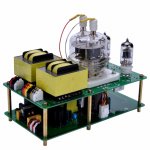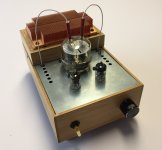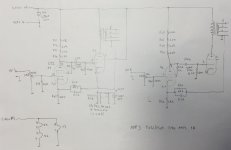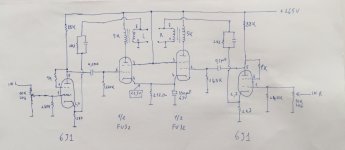I have ordered this amplifier. It is fully assembled, the lower board is the SMPS and the upper board the audio part. It has 500 mV input sensitivity and outputs for 4, 6, and 8 ohm speakers, the power supply range is 90 - 264 VAC.
For a quick test, I connected a power cord, two RCA jacks and my Lowther backloaded horns.
My first surprise was, how silent it is. The Lowthers are very sensitive but in this case, I need to get really close with my ear to hear some very slight hiss. And there is absolutely ZERO hum. The sound of this little amp is the best I have heard so far in my room. I think I would have to go to the DHT SE triode league to get something better. All this for ca 120 USD including priority shipping.
So now the DIY part comes in, I need to buy some connectors, switches and knobs and build some well ventilated chassis.
In my opinion, using a SMPS with tubes is the best of both worlds. I may try to do some FR and distortion measurements later. I just think this is a steal deal. I ordered an extra set of tubes for another 10 USD and I am really considering buying more for my multiamped high efficiency setup.
For a quick test, I connected a power cord, two RCA jacks and my Lowther backloaded horns.
My first surprise was, how silent it is. The Lowthers are very sensitive but in this case, I need to get really close with my ear to hear some very slight hiss. And there is absolutely ZERO hum. The sound of this little amp is the best I have heard so far in my room. I think I would have to go to the DHT SE triode league to get something better. All this for ca 120 USD including priority shipping.
So now the DIY part comes in, I need to buy some connectors, switches and knobs and build some well ventilated chassis.
In my opinion, using a SMPS with tubes is the best of both worlds. I may try to do some FR and distortion measurements later. I just think this is a steal deal. I ordered an extra set of tubes for another 10 USD and I am really considering buying more for my multiamped high efficiency setup.
I use SMPS in a lot of my builds. Usually for low power stuff like VA/PI and driver. Heaters too...
Surprising how loud 3W can be...
Surprising how loud 3W can be...
I have a headphone amp that uses a SMS. It's get quiet. It's switchable from 16 ohm to 600 ohm. The little output transformers sound nice too. I was suprised. It puts out 1.2 wpc into 16 ohms. I guess it could be used as a flea watt amp. I was wondering about that FU32 amp myself.
Just a small update. For lack of skills, I ordered the acrylic case designed for this amp with all the connectors and switches. Finally, yesterday I put everything together and tried again with my Hedlunds. Very detailed and enjoyable sound. I hear things I have not heard before🙂 The only thing is, that the very low end is missing from the horns, so a subwoofer is definitely needed.
I attach the pictures of the FU32-6J1 board I bought in april 2018 and the custom enclosoure I've built with bamboo wood, a laser cutted steel plate and a copper heat spreader. I also designed several modifications to the board; I can post them here if you are interested.
Attachments
I attach the schematics of my amplifier. I mostly worked on the SMPS board; in the bottom left corner are my modifications. This power supply is regulated on the filament supply output; the HT output is unregulated. On my board the filament supply factory voltage was 11V. The correct value for a 832A / FU32 tube is 12.6V. I adjusted the output voltage by replacing the R59 and R60 resistors on the feedback loop. But now the TOP271EG controller enters the hiccup protection mode when the amplifier is hot and the power is quickly turned off and then on again, because it is not capable to supply the normal surge current draw from a cold tube filament, and the soft start ferature has not been implemented by the board designer. The very high value capacitors on the outputs guaratees that the circuit will never exit the hiccup mode, because as soon as the SMPS starts, the current draw from the big capacitors adds to the tube filament current draw and triggers the overcurrent protection again. I fixed this by adding a 2.2 ohm NTC in series with L02 and replacing C08 with a small film capacitor: this also helps reducing the HF harmonics. I also removed the C04 filter capacitor at the input, and replaced C03 with a high quality high temperature 100uF Nichicon.
The last issue that needed to be fixed on my board is the B+ value: after the modifications it climbs to 265V, 15V more than the 250V max G2 value for 832A / FU32. I solved this by adding a 2.2K resistor between the FU32 pin 3 (g2) and B+ and a 10uF capacitor between pin 3 and ground. Finally, I added grid stopper resistors at the FU32 grid inputs.
A cute small amplifier with a cool looking tube, but output transformers are small and low quality and the weak SMPS board becomes worringly hot after a few hours: I had to place a big heatsink on the bottom of my chassis, coupled to the board with heath transfer material, to avoid thermal shutdowns of the SMPS. It would be interesting to see if they fixed the undervoltage/underpower issue on your later board.
The last issue that needed to be fixed on my board is the B+ value: after the modifications it climbs to 265V, 15V more than the 250V max G2 value for 832A / FU32. I solved this by adding a 2.2K resistor between the FU32 pin 3 (g2) and B+ and a 10uF capacitor between pin 3 and ground. Finally, I added grid stopper resistors at the FU32 grid inputs.
A cute small amplifier with a cool looking tube, but output transformers are small and low quality and the weak SMPS board becomes worringly hot after a few hours: I had to place a big heatsink on the bottom of my chassis, coupled to the board with heath transfer material, to avoid thermal shutdowns of the SMPS. It would be interesting to see if they fixed the undervoltage/underpower issue on your later board.
Attachments
Thanks. I yesterday experienced the hiccup mode, I had to let it sit for a minute to be able to turn it on again. When I have some time to work on the amp, I will measure the voltages and look if I am able to do some of your mods - I would go for the NTC and vap replacement. If the amp did not have the hiccup mode before adjusting the voltage, the it would indicate that they have fixed this.
- Home
- Amplifiers
- Tubes / Valves
- Chinese 6J1 + FU32 Class A SE 3+3 W




